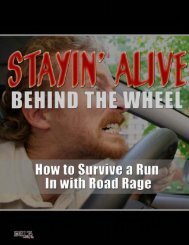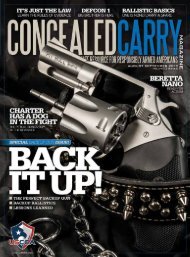Download This Issue - US Concealed Carry
Download This Issue - US Concealed Carry
Download This Issue - US Concealed Carry
You also want an ePaper? Increase the reach of your titles
YUMPU automatically turns print PDFs into web optimized ePapers that Google loves.
the defender can feel misunderstood.<br />
I have not seen this more clearly demonstrated<br />
than in the homecoming of<br />
American servicemen and women from<br />
the Viet Nam War. Rarely were these vets<br />
asked about the meaning of combat and<br />
killing to them. Instead, many civilians<br />
simply ran their agenda on the vulnerable<br />
young military returnees, which vets<br />
continue to tell me was the hardest part<br />
of their adjustment. If a soldier was trying<br />
to come to grips with his taking human<br />
life, it was often no more helpful to<br />
cheer his killing of the “godless gooks,”<br />
than it was to call him a “baby killer.”<br />
Either of these extreme responses offers<br />
the Mark of Cain to the warrior, and his<br />
most likely internal response is to feel<br />
that he no longer fits in the country he<br />
recently defended.<br />
Sometimes the Mark of Cain is selfassigned<br />
as the person comes to understand<br />
his responsibility in a lethal encounter.<br />
In real life, things are rarely as<br />
neat as tactical scenarios where an IPSC<br />
target with a gun on it pops up and says,<br />
“I’m going to kill you.” It is natural and<br />
even healthy (to a point) to question<br />
what was done. <strong>This</strong> is a way we learn<br />
and integrate our personal experiences<br />
into a meaningful story of who we are<br />
and how we’ve been in the world. The<br />
problem can come when we get stuck<br />
in negative emotional judgments about<br />
what we have done, in spite of all the<br />
evidence and opinion to the contrary.<br />
Whether or not a person encounters<br />
PST or PTSD in the aftermath of their<br />
experience, it is important to recognize<br />
that the defender’s brain has gone on a<br />
strange ride and may take some time<br />
coming back to its usual mode of operating.<br />
<strong>This</strong> is too short an article to elaborate<br />
on the changes that take place<br />
and distortions of perception. The important<br />
point here is to understand that<br />
the person may have stored information<br />
about the event in a fragmented and<br />
highly-charged way in the emotional<br />
centers of the brain. <strong>This</strong> becomes possible<br />
as the brain switches to the fight<br />
or flight system to process what is happening.<br />
Under some circumstances,<br />
the brain can become overwhelmed<br />
and stay in that state for an indefinite<br />
period. When this occurs, the memory<br />
of the event cannot be accessed without<br />
bringing up the disturbing emotion<br />
that was stored with it. The result is<br />
that the person knows one truth about<br />
the event logically, but the logical mind<br />
gets overwhelmed by the emotionallycharged<br />
memory. That accounts for<br />
folks with PTSD and PST reliving the<br />
event through flashbacks, nightmares<br />
and all-too-realistic recall of the events.<br />
The same person is likely to avoid any<br />
person, place or thing that would serve<br />
as a reminder of the event. They live in a<br />
state of unending hypervigilance, which<br />
is not a fun place to be and they would<br />
do anything to get out. But stuffing the<br />
memory of the event is not successful<br />
Some of the folks that<br />
I have seen have the<br />
worst time with PVET<br />
were people that<br />
acquaintances would<br />
describe as strongminded.<br />
They are often<br />
the last to come to<br />
counseling due to their<br />
expectations that they<br />
should pull themselves<br />
up by their own<br />
bootstraps.<br />
and when they try to bring the event<br />
up in their mind, emotion overwhelms<br />
logic.<br />
The human brain is designed to process<br />
traumatic events and will do so<br />
over the days and weeks following the<br />
incident if it can. But if the wrong combination<br />
is present and the brain stays<br />
overwhelmed by the traumatic memories,<br />
what might have been an unpleasant<br />
short-term case of PST/PVET can<br />
harden into the longer-term PTSD.<br />
It is easy to get frustrated with a person<br />
who is undergoing this experience,<br />
especially if we don’t understand that<br />
their efforts to look at things rationally<br />
are getting overwhelmed by the emotional<br />
memories. Some of the folks that<br />
I have seen have the worst time with<br />
PVET were people that acquaintances<br />
would describe as strong-minded. They<br />
are often the last to come to counseling<br />
due to their expectations that they<br />
should pull themselves up by their own<br />
bootstraps. When they haven’t been<br />
able to control the emotional flooding<br />
that occurs, they believe themselves to<br />
be failures and they tend to become depressed.<br />
The advice of well-intentioned<br />
friends to suck it up and move on further<br />
deepens their sense of failure and<br />
depression, because they can’t get on<br />
with it.<br />
The point of all this is to encourage<br />
persons in the shooting community to<br />
understand that adequate, confident,<br />
competent, intelligent folks can and do<br />
fall prey to PST/PVET or PTSD. Again,<br />
not everyone who goes through a bad<br />
experience will go through these symptoms.<br />
But some will.<br />
Once a defender can accept that they<br />
have PST/PVET or PTSD, they can then<br />
take charge of the healing processes<br />
involved. Police officers have the resources<br />
of fellow officers who have gone<br />
through similar events, peer counselors,<br />
and privileged communications with<br />
a police chaplain. Armed citizens can<br />
form their own ad hoc support group<br />
from understanding friends. A great<br />
new resource for understanding with<br />
some clout is the Armed Citizens Legal<br />
Defense Network (www.armedcitizensnetwork.org).<br />
For those whose symptoms are persistent<br />
and troubling, therapy through the<br />
use of Eye Movement Desensitization<br />
and Reprocessing (EMDR) has been a<br />
helpful process in the resolution of trauma<br />
for law enforcement, civilians and<br />
military personnel. Information about<br />
the therapy and practitioners can be<br />
found through the EMDR International<br />
Association website (www.EMDRIA.<br />
ORG). n<br />
[ Art Mize is a Licensed Mental Health<br />
Counselor in private practice in<br />
Olympia, Washington. He also serves as<br />
a volunteer police chaplain and a defensive<br />
handgun instructor. ]<br />
More Resources<br />
“Post-Violent Event Trauma” (video)<br />
Massad Ayoob<br />
Deadly Force Encounters by Alexis<br />
Artwohl and Loren Christensen<br />
Into the Kill Zone by David Klinger<br />
CopShock by Allen R. Kates<br />
38<br />
<strong>US</strong>CONCEALEDCARRY.COM n CONCEALED CARRY MAGAZINE n JULY 2008
















